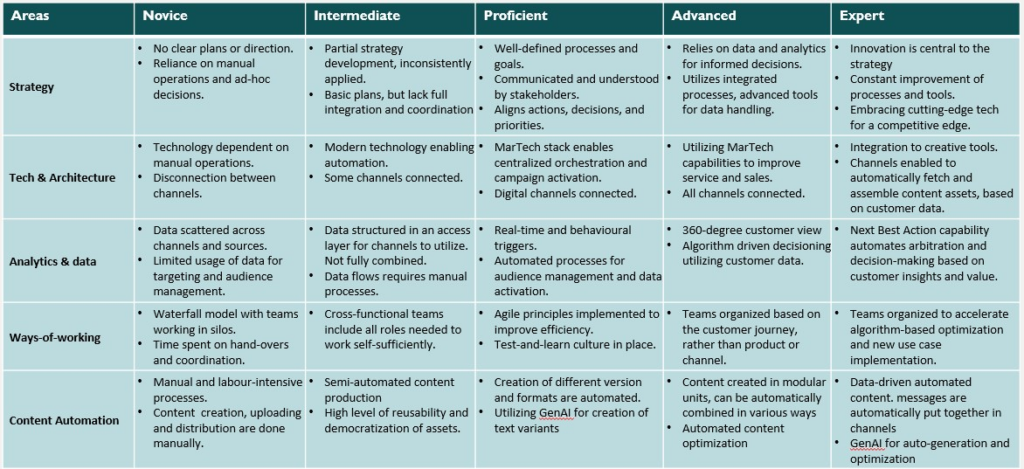I expect personalization.
Period!
Customers expect personalization
Most customers expect personalization these days. I want relevance in my interactions with companies. If not, it is a waste of my time, and like everyone else, I have very little time. Unfortunately, I often get disappointed. Many companies fail to understand my needs and what is relevant to me at a given point. I don’t even open email communication from most companies anymore because it feels like spam.
But to be fair, it is not an easy task, and being in the MarTech field myself for the past 10+ years, I know the struggle. For a company to be able to offer a personalized experience, several processes need to be automated, which, in turn, requires investments in MarTech, including technology, data, and skills. But when done right, MarTech transformations really make a difference. Studies confirm that companies mature in MarTech and personalization show higher revenues and better growth.
But first, what is MarTech? MarTech is short for marketing technology. But wait, it is really not just tech; a common misunderstanding. It is really the full scope of creating happier customers and making more money with better customer communication. And this involves people, skills, processes, and tech. MarTech is used to drive growth, optimize operations, and enhance customer experience. MarTech impacts many parts of the organization and requires collaboration among them. To be successful, this means that existing organization and processes must be adapted to achieve desired results. So again, tech is involved but it’s much more than tech, and it never starts with tech!
Confused? Feel guilty about sending mass communication to your customers. You are not alone, but it is time to get started on your MarTech journey. Like mentioned above, it is complex, and how do you know if you are doing it right and if you are moving all pieces that you should be moving? Don’t worry; there is help to be found. Based on my own experience from implementing MarTech processes and driving digital transformation for a larger Telco, I have developed a model to guide you through the MarTech journey. Hopefully, this can help you in assessing your organization’s maturity level and navigate you through the different stages. However, there’s no one-size-fits-all approach; it depends on factors like company size, industry, and goals.
MarTech Maturity

Maturity levels:
- Novice: Initial stage, mostly manual operations, lacking strategy.
- Intermediate: Some processes in place, basic tool usage, sporadic strategy.
- Proficient: Well-defined processes, use of integrated tools, clear strategy.
- Advanced: Highly integrated processes, extensive tool ecosystem, data-driven strategy.
- Expert: Cutting-edge tools and processes, fully optimized, ongoing innovation.
Let me give you the highlights:
- Strategy: In the more early stages, you mostly see ad hoc and scattered initiatives. To move to the next level, start aligning effort with your overall strategy and business objectives. MarTech is never isolated from the business. It is a means to run your business. Getting to the top of maturity, you can really drive innovation as part of your MarTech, think AI-driven content, AI-driven decision-making, highly automated orchestration.
- Tech: The starting point is most likely disconnected tech and legacy with no possibility to scale and with a dependency on manual processes. To mature, you need to connect your channel silos and integrate with real-time capability. If you want to be best in class, make sure you can automate end-to-end, including content creation.
- Analytics and data: Often data quality is low, data is scattered, and availability is limited and ad-hoc. Manual work is involved in making the data accessible. In the most mature state, you have full control of your data with a 360-degree view of your customers, and your data quality is high enough to allow for automated decision-making.
- Way of working: Often, the starting point is silos and traditional processes with a lot of work spent on coordination and handover and project management. As the org begins to mature, the focus can move to cross-functional teams, often starting in product and later maturing to customer journeys. At the most mature point, teams are organized to optimize the automated process, with one team working on ideation and new use cases, enhancing or developing models, and one ad-hoc team.
- Content automation: This does not occur like an issue in the beginning of the personalization journey, but trust me, this will be a blocker later. I wish I would have understood earlier. It does not matter that you can personalize if you have nothing to personalize around. To personalize a customer meeting, you need larger amounts of content assets like copy, images, offers, video, etc. If not, what was your purpose?
Think about being able to shift your focus to spending 80% of your time thinking about how to meet your customer in the best possible way versus spending the same amount of time thinking about who should get what message. This is what becomes possible if you are successful in your MarTech automation journey.
Hopefully, this framework has provided some inspiration in setting your MarTech direction and roadmap and helped you understand the importance of personalization. Do you need further clarification or discuss your company’s maturity.
Deerdata is here to help!
Read more about marTech to maximize the value of your investments.




